Summer 2022 is approaching. It will be under the continued influence of the La Nina, which will create a hotter than normal and drier Summer for parts of the United States and Europe. The latest forecast cycle shows a strong La Nina signal in the weather patterns.
When trying to understand any weather season and the long-range forecasts, we must realize that there are many global drivers that define it. Global weather is a very complex system, with many large-scale and small-scale factors.
Seasonal forecasting focuses on large-scale pressure systems and the jet stream positioning with the weather pattern. Over the Northern Hemisphere, this upcoming Summer season will be under the influence of a now well-known Ocean anomaly.
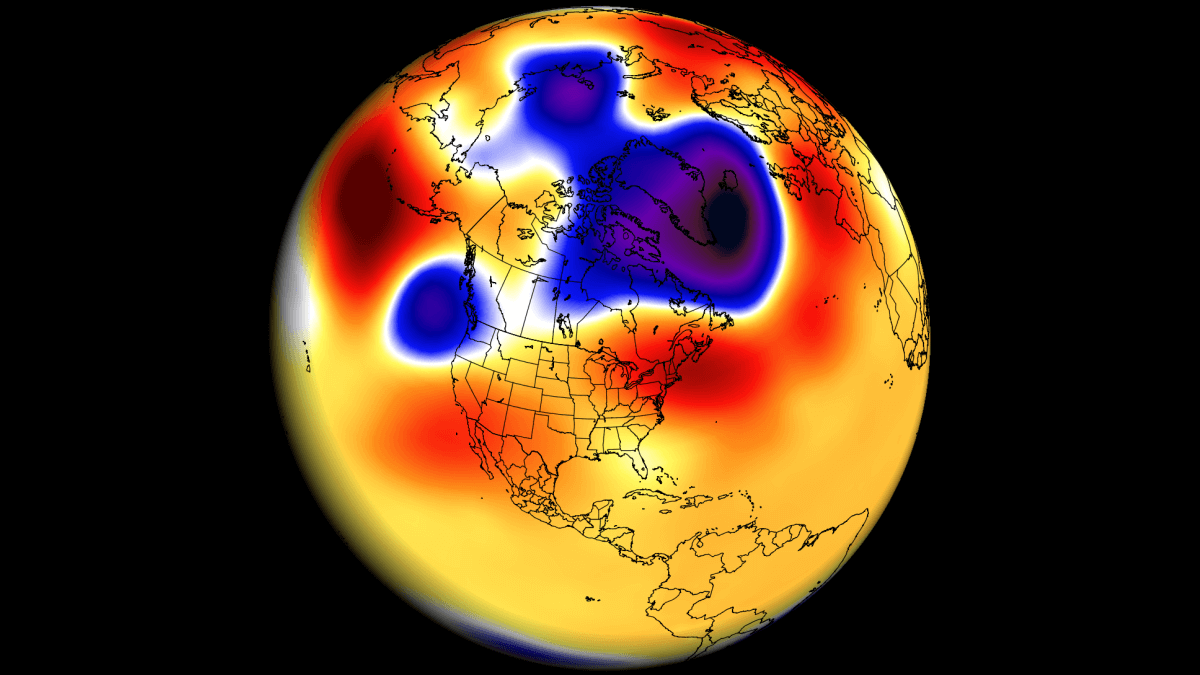
OCEAN AND THE WEATHER
A major driver of the last cold season was the ENSO. That is short for “El Niño Southern Oscillation”. This is a region of the tropical Pacific ocean that is experiencing warm and cold phases in the ocean. Typically there is a phase change in around 1-3 years.
Below we have an image that shows all the ENSO regions in the equatorial Pacific. The main regions are 3 and 4 and cover a large part of the tropical Pacific. The main region is marked as Nino 3.4, partially covering both the 3 and 4 regions.
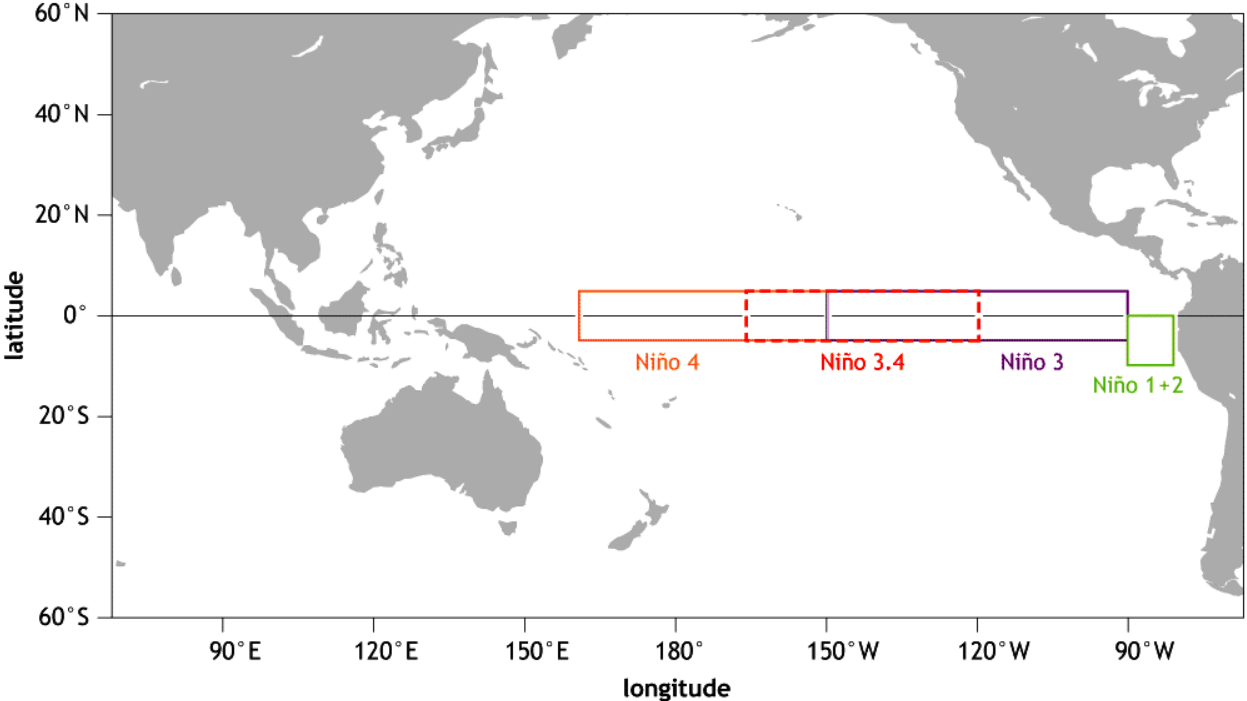
ENSO has a major influence on the tropical weather patterns and the complex exchange between the ocean and the atmosphere. Large-scale pressure changes are observed in the tropics as ENSO phases begin and as they reach their peak.
The image below from NOAA Climate shows the typical circulation during a negative ENSO ocean event (La Nina). Air is descending in the eastern Pacific, creating stable and dry weather conditions. In contrast, air rises in the western Pacific, causing clouds and a lot of rainfall in the western Pacific.

Through this process, ENSO has a direct impact on the tropical convection patterns and thus on the ocean-atmosphere system.
The cold ENSO phase is called La Nina and the warm phase is called El Nino. Besides the temperatures, one of the main differences between the phases is also in the pressure anomalies they produce.
Below we have the latest global ocean anomalies, revealing the cold region in the tropical Pacific. That is the currently active La Nina phase. We have marked the main 3.4 region.

Focusing on this ENSO 3.4 region, you can see in the image below how the ocean temperatures dropped in Fall last year which was the start of the La Nina. It remained stable over the cold season and is forecast to stay for the Summer and into Fall 2022 at the minimum.

Below we have the latest ocean temperature anomaly forecast for the Summer season from multiple global long-range models. It shows cold ocean anomalies in the tropical Pacific Ocean, with the peak in the enso 4 region.
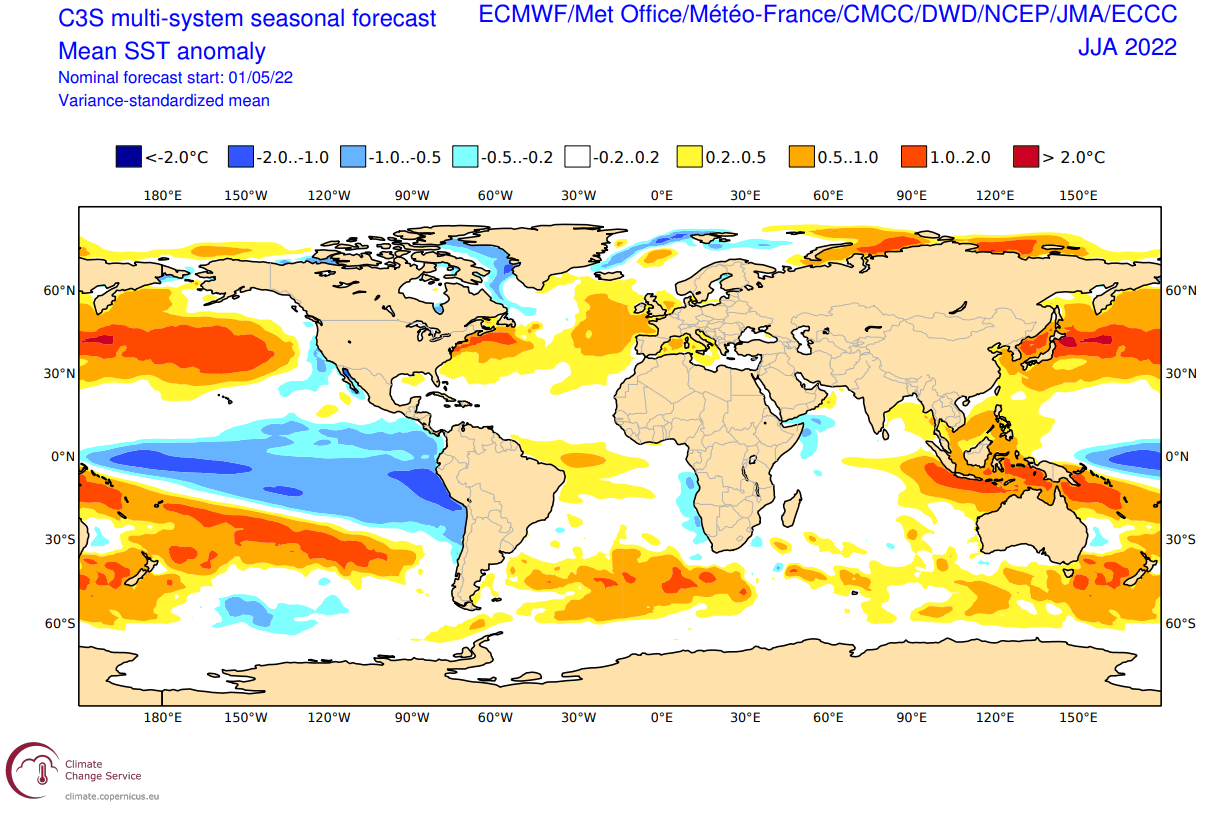
The ECMWF ensemble forecast for the western Nino 4 region shows the sustained negative anomalies over the summer and even into fall. Latest trends show that this La Nina phase will continue into the Winter of 2022/2023.
For a better idea of the ENSO development, we produced a video that shows the La Nina anomalies from Winter to Spring.
The video below shows the cold ocean anomalies in the equatorial Pacific. Notice the “waveforms” across the region, as the surface waters are being pushed west by the trade winds.
Knowing what is behind the global weather patterns on a larger scale, we can now look at its expected influence on the Summer weather.
FROM PAST TO PRESENT
Typically, the first influence of these ocean anomalies can be seen in the changing jet stream. The jet stream is a large and powerful stream of air (wind) at around 8-11km (5-7mi) altitude.
It is driven by the temperature difference between the cold polar regions and the warmer tropics. It flows from west to east due to the rotation of the Earth.
In the image below you can see a simplified visualization of the global jet stream. The polar jet stream is more important during the cold season, while the subtropical jet stream plays a bigger role also during the warm season.
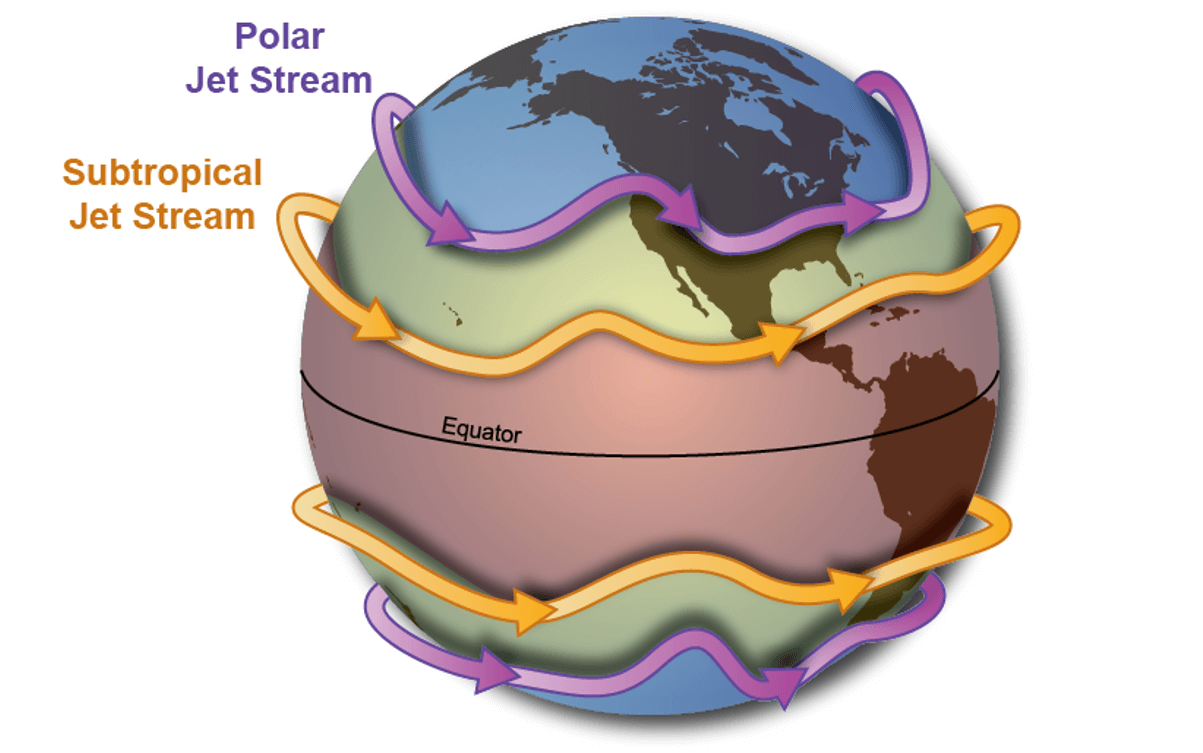
Historically, the most typical winter effect of a cold ENSO phase is a blocking high-pressure system in the North Pacific. You can see that it bends the polar jet stream from western Canada down into the northern United States. The image also shows the resulting weather patterns in the United States and Canada during a La Nina Winter.
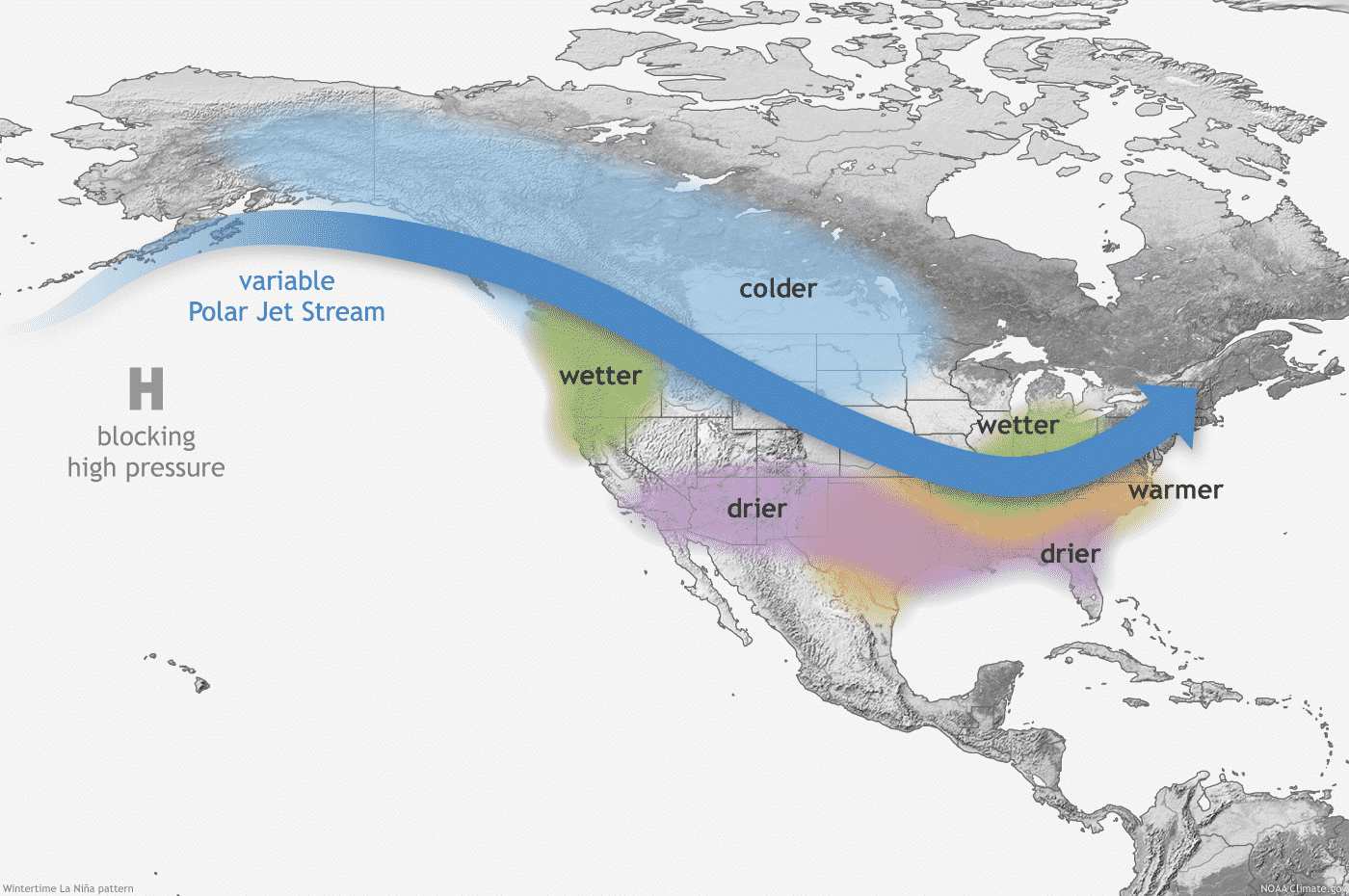
The shifting jet stream brings colder temperatures and storms down from the north into northern and the northwestern United States, and warmer and drier weather to the southern parts.
But what is the La Nina weather pattern influence in Summer? We are focusing on the Pacific/North American region in this case, because the warm season La Nina influence is most profound here.
Below we have a historical weather pattern, combining several Summer seasons with the La Nina influence. We can see that typical high pressure in the North Pacific ocean. It also shows a secondary high-pressure zone towards eastern Canada.
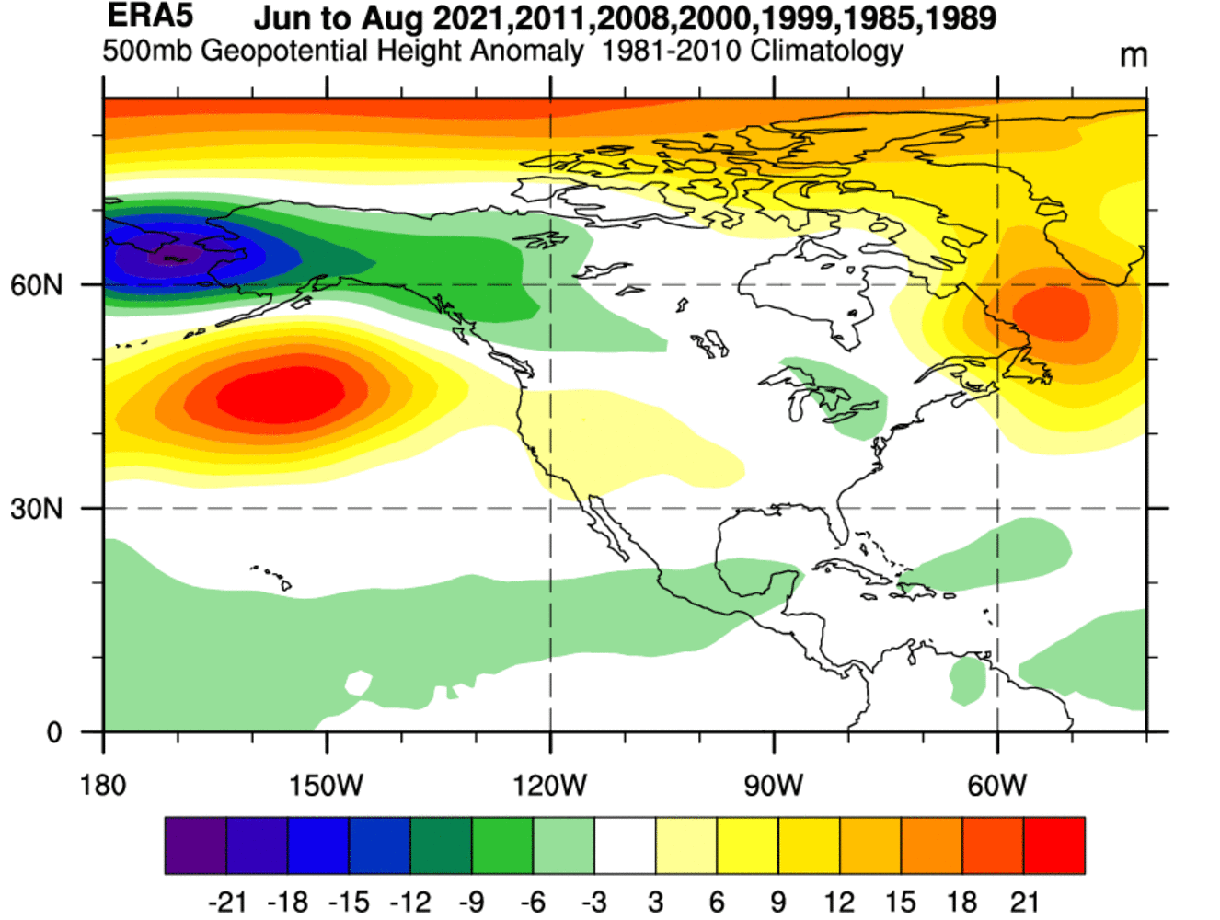
Looking at the surface temperature anomalies of the same years, we see warmer than normal temperatures over much of the western and southern United States. And also over eastern Canada. But take note of the temperature pattern in the Ocean.
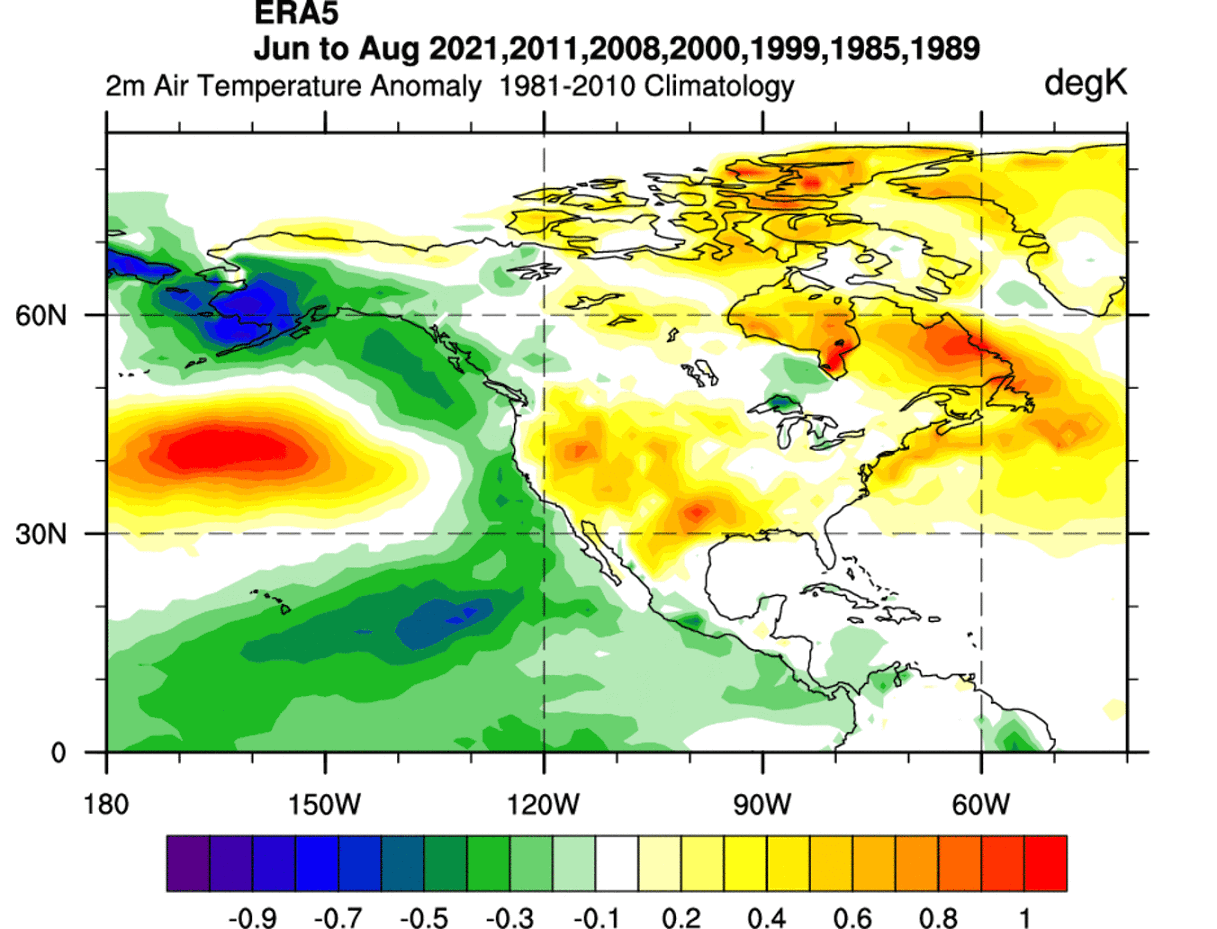
In the North Pacific, we can see a warm pool developed, with a cold “horseshoe” pattern along the west coast of North America. This is a negative PDO pattern and is an important factor in weather development.
Looking closer at the latest ocean temperature anomalies in this region, we can see a very similar if not the same pattern. A warm pool in the central North Pacific and a cold anomaly along the west coast of North America.
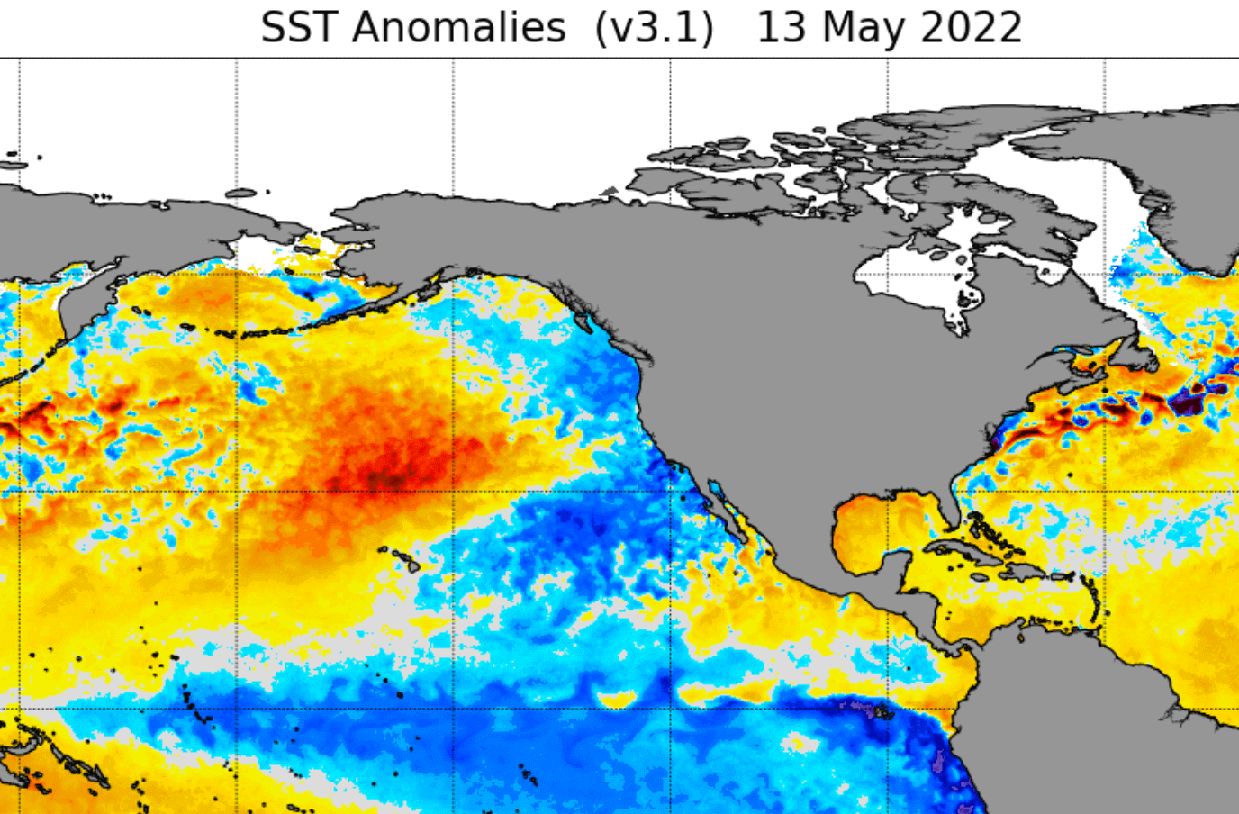
This gives higher confidence that a La Nina summer pattern is indeed setting up, and the historical data can provide decent guidance.
Precipitation-wise, we have a drier signal in a La Nina Summer over much of the north, central and south-central United States. More precipitation is recorded over the Ohio Valley and the northeastern United States, and also partially in the southwest.
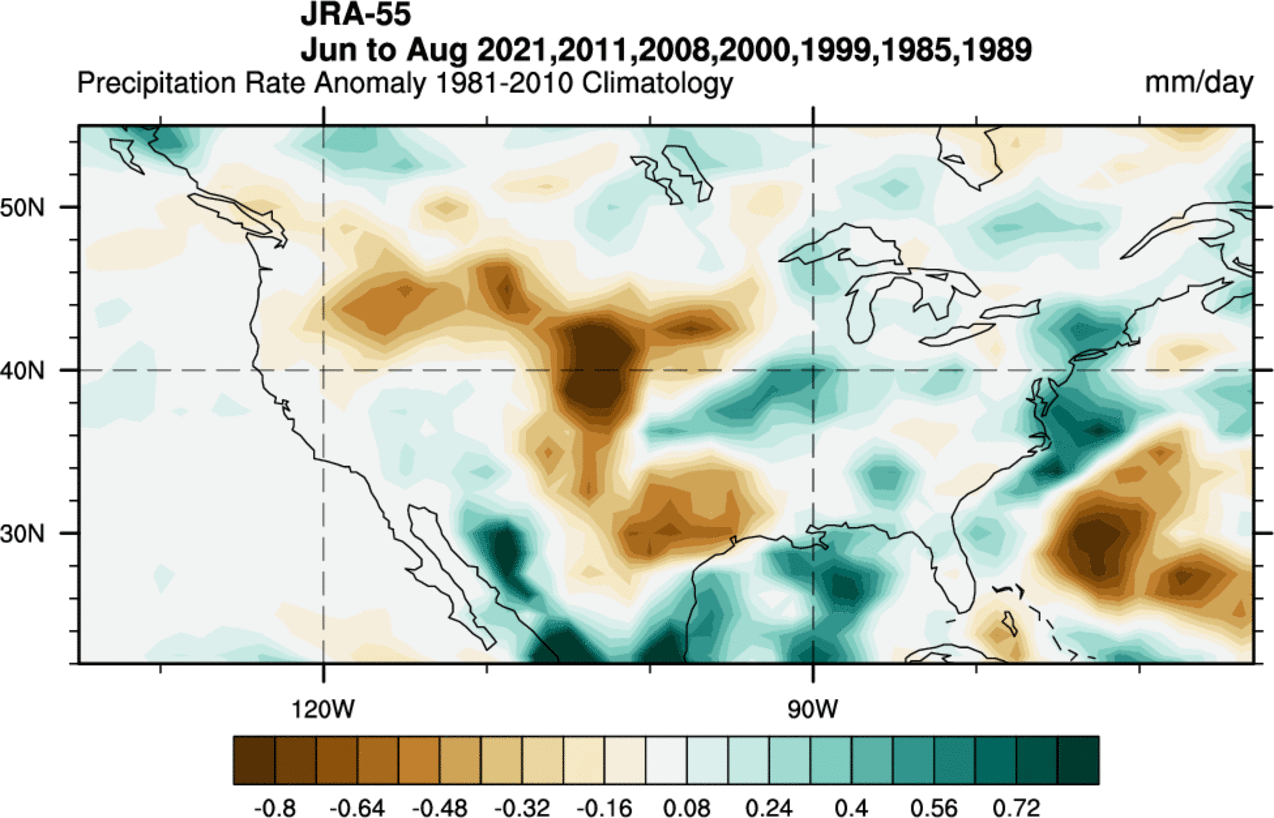
Overall, a La Nina summer pattern supports warmer than normal and drier conditions over the western and central United States. This is the main takeaway due to the already present drought conditions.
ECMWF SUMMER 2022 SEASON FORECAST
Knowing now what to expect from the La Nina in Summer, we can take a look at the latest long-range forecast trends.
We typically use the ECMWF first, as is often referred to as the most reliable model for long-range forecasting. In reality, a lot can change in each individual year/season. But generally, the ECMWF model is at the top as far as “reliability” goes.
But no long-range/seasonal forecasting system can be called “reliable“. We are only forecasting trends and how the weather patterns are evolving on a large scale and over longer time periods.
The forecast period we will be focusing on is June-July-August (JJA 2022). This period covers the meteorological summer and is the peak of the warm season.
In the pressure pattern forecast from ECMWF below, we can see a La Nina high-pressure system present in the North Pacific. It extends into the western/northern United States.

A secondary high-pressure area is found over the northeastern United States as we have seen in the La Nina signal graphic earlier above. This will have a regional effect on the weather development in the eastern United States and eastern Canada.
Another high-pressure system is over Europe, with a low-pressure area over Greenland and the North Atlantic.
The global temperature distribution follows this pattern. Over North America, we see peak warm anomalies over the central and northwestern United States. That is the warm air mass under the high-pressure anomaly. Warm anomalies also extend over much of southern and eastern Canada.

Looking closer at Europe below, we see much warmer than normal weather over much of the continent. But the exception is far northern Europe, which will be more under the influence of a low-pressure system and a westerly flow.
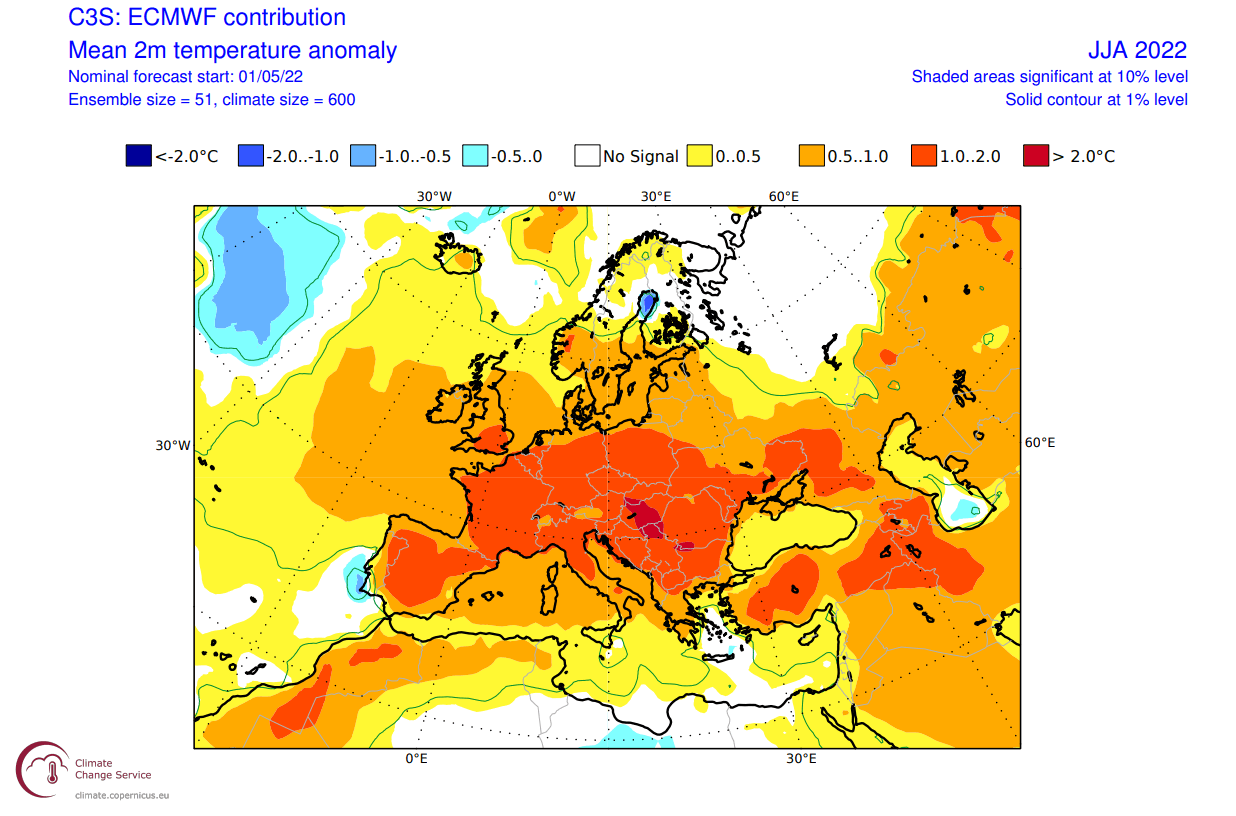
Over North America, we can now better see the warm pooling over much of the central and western United States. The far southern and southeastern United States however does feature a weaker anomaly zone, similar to the historical La Nina summer pattern.
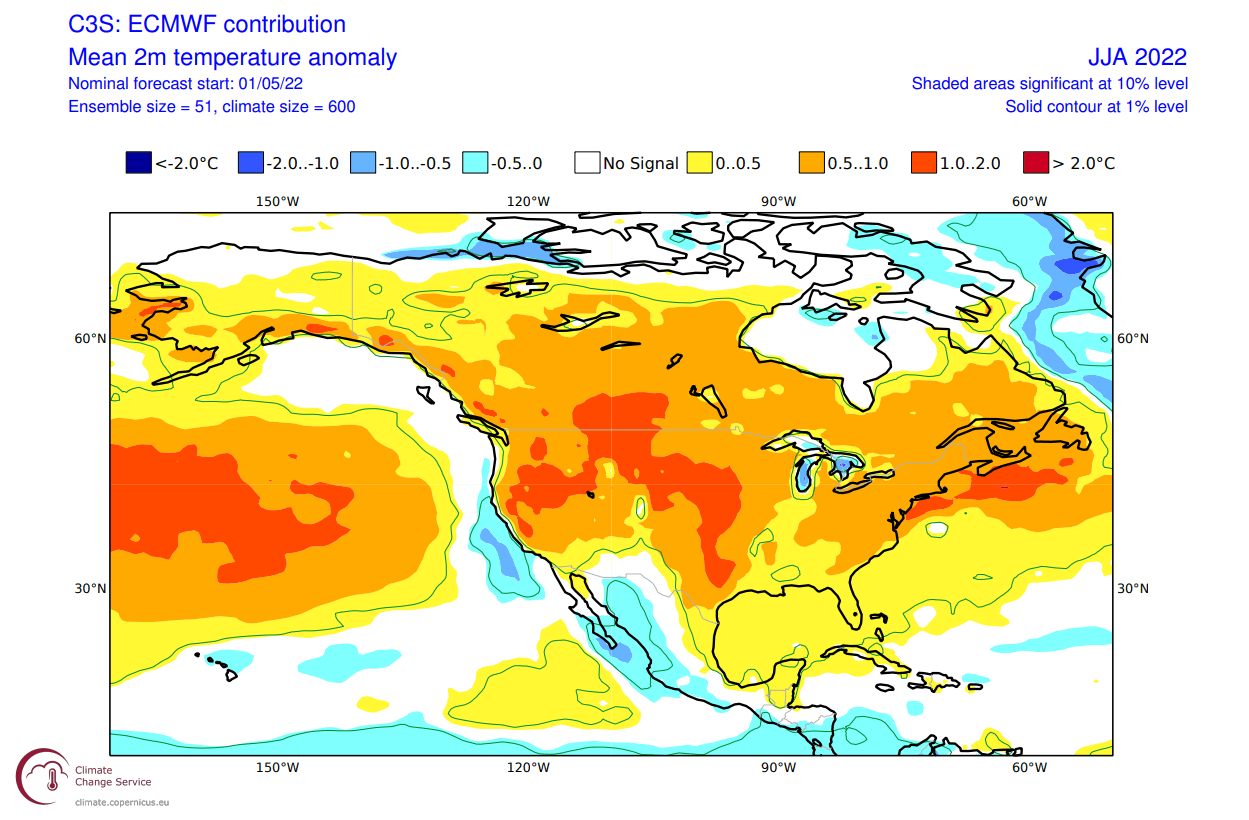
Warm anomalies are also forecast over much of central and eastern Canada, and also the northeastern United States. That region is under the influence of the high-pressure system over the area.
Precipitation-wise, normal to wetter conditions will prevail over far northern Europe, close to the low-pressure zone. But the rest of the continent is expected to be drier than normal, creating likely drought scenarios over the continent.

The precipitation forecast over North America shows drier conditions over most of the central and northern United States. But parts of the southwestern and eastern United States, and eastern Canada have a higher chance of wetter conditions. Similar to the historical La Nina pattern as well.

Combined with the strong warm temperature anomalies for the south-central United States, so far this looks to be a hot and dry Summer development for south-central states and further up into the Midwest.
UKMO SUMMER LONG-RANGE FORECAST
Our second model of choice is the UKMO model, from the United Kingdom Met-Office. This has also shown good performance in the past seasons, so we tend to include it in our standard “suite” of long-range forecasts.
In the pressure pattern forecast from UKMO below, we can see also see the La Nina high-pressure system in the North Pacific. But in this forecast, the secondary high-pressure anomaly is sitting more to the west, over the northern United States and southern Canada, compared to the ECMWF.

A high-pressure system is indicated over western Europe, with a low-pressure area over northern Europe. Similar to the ECMWF forecast.
The global temperature anomalies show the main warm anomaly region over the northern half of the United States and southern Canada. That is the warmer airmass under the secondary high-pressure anomaly.
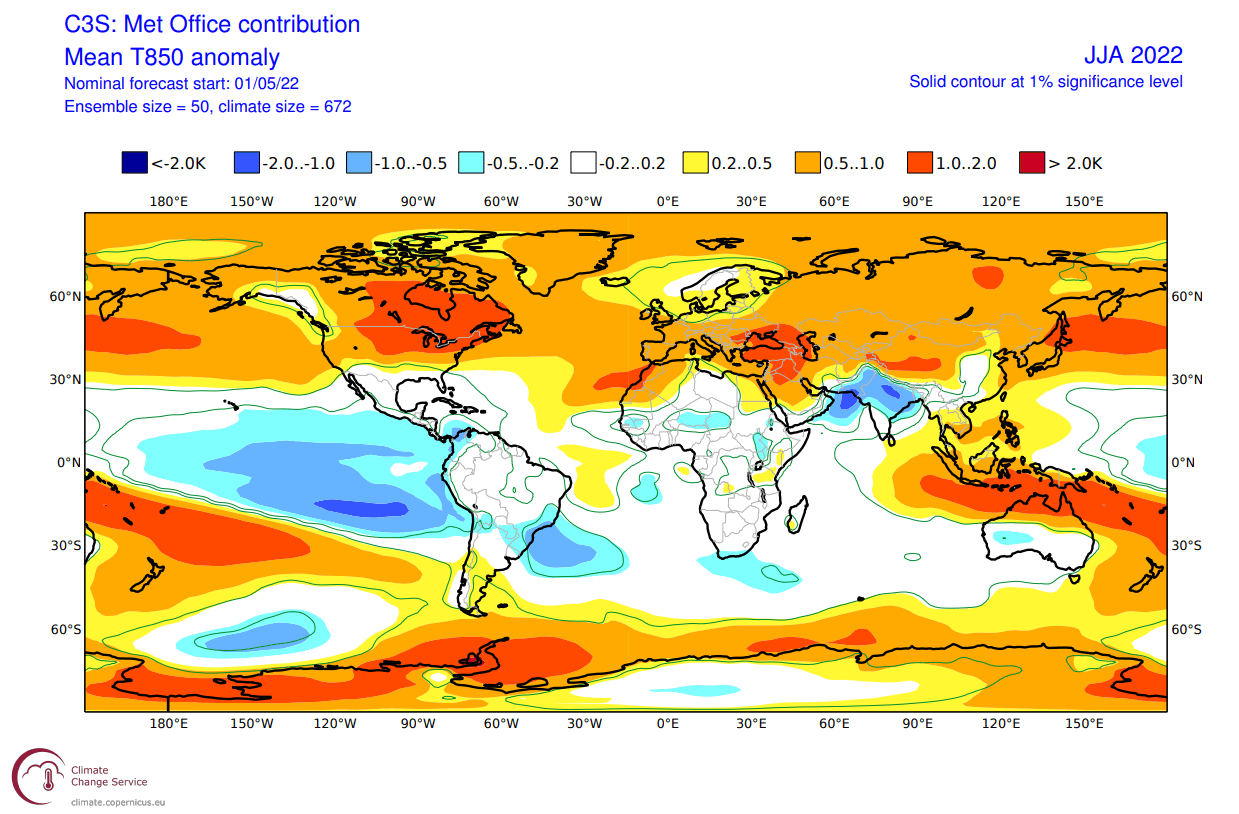
Looking closer at Europe, we see warmer than normal weather over most of the continent, but not as strong as in the ECMWF. The exception is Scandinavia, which will be close to the low-pressure zone and the polar jet stream.

Over North America, we can now better see the strong warm pooling over much of the central and northern United States. The far southern United States however does feature weaker anomalies. That is also an expected signal of the La Nina influence.

Warm anomalies are also forecast over much of Canada, peaking in the central and eastern regions.
Precipitation-wise, normal to wetter conditions will prevail over far northern Europe, close to the low-pressure zone. But the rest of the continent is expected to be drier than normal, with a likely active storm season in central parts of the continent.

The UKMO precipitation forecast over North America also shows drier conditions over most of the central and northern United States and southern Canada. But like the ECMWF it hints at wetter conditions over southwestern and parts of the eastern United States.
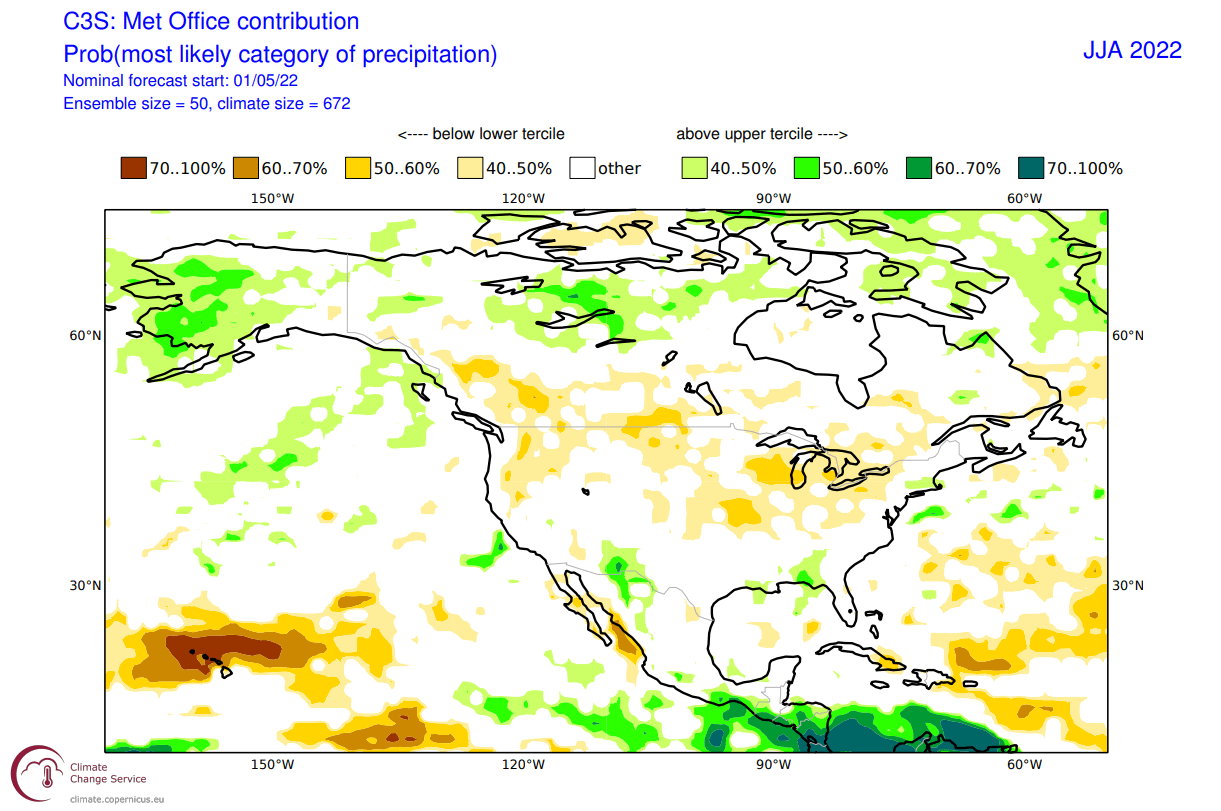
This is now the second model that basically shows a hot and dry summer for the central United States and also further up into the Midwest.
CFS SUMMER 2022 SEASONAL FORECAST
In contrast to the European models, we now use the main North American long-range model, the CFS version 2 from the NOAA/NCEP in the United States.
The CFS model is close to the ECMWF, with a high-pressure system in the North Pacific and a second high-pressure zone over the northeastern United States. This is a confirmed La Nina influence forecast for the upcoming Summer.
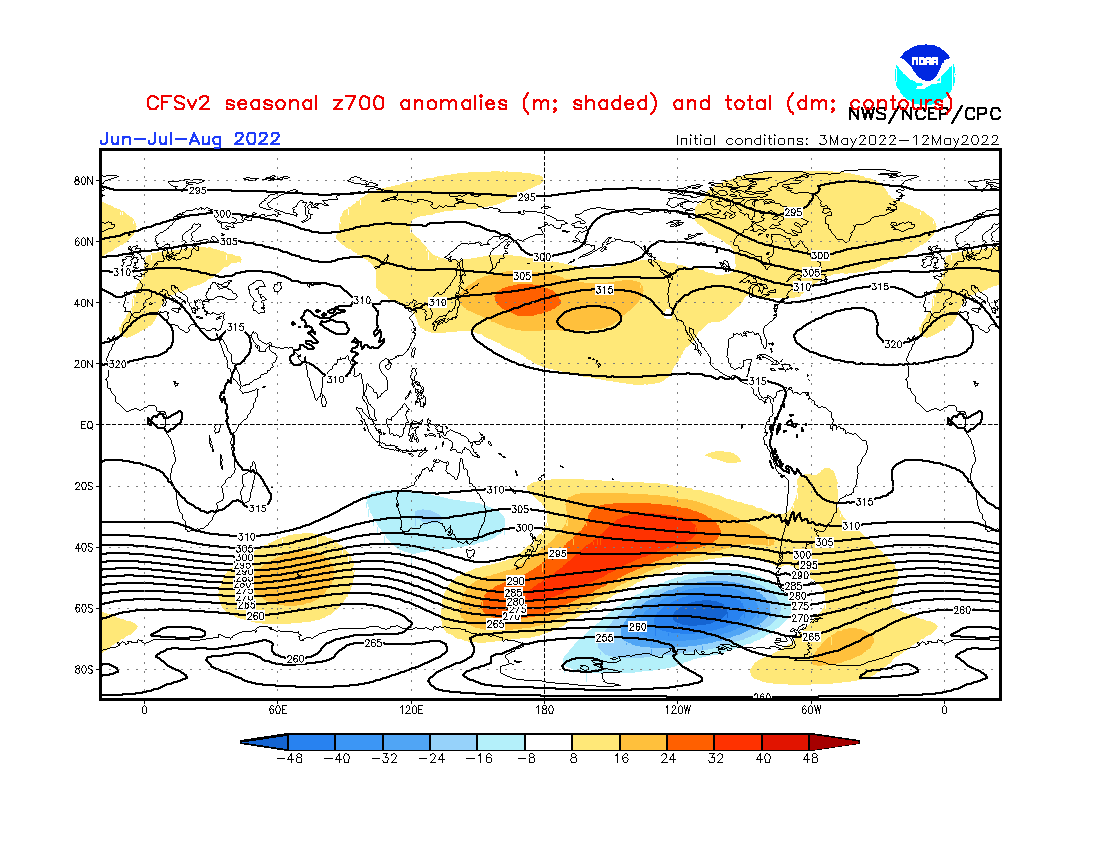
Over Europe, the high-pressure anomaly is forecast over central Europe, and a potential low-pressure zone to the north, like in the previous two models.
Global airmass temperatures are of course warmer than normal over much of the Northern Hemisphere. Some of it is due to the model averaging/bias and the long lead time. But there is still a pattern in this otherwise straightforward forecast.
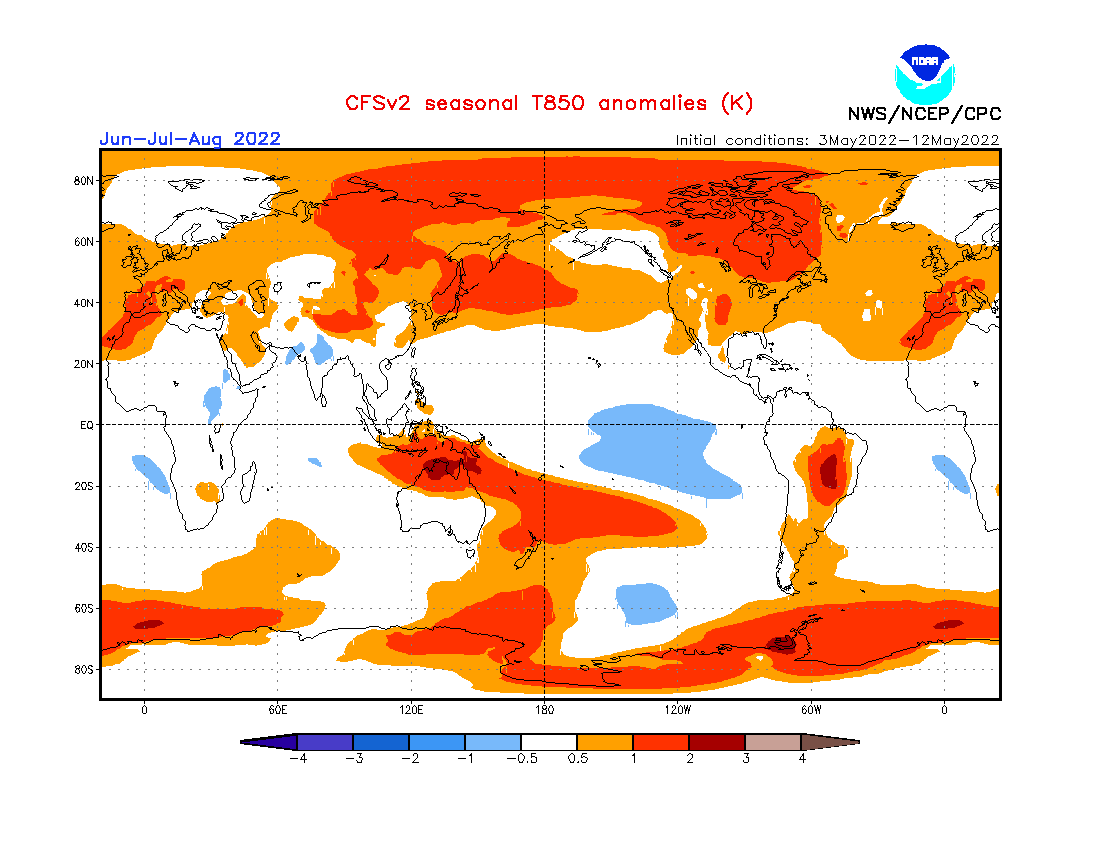
Looking closer at Europe, the surface temperatures are warmer than normal over most of the continent, especially central and western regions. A more likely scenario is the reduction of warm anomalies towards the north, with a low-pressure zone.

The North American temperature forecast below shows a similar pattern to the previous two models. The main core of the hotter Summer weather is forecast over the south-central United States. Stronger warm anomalies are also forecast for much of eastern and northern Canada.

Looking at precipitation in Europe, we see mostly drier Summer conditions across the continent. Wetter conditions are most likely for the far north and the British isles, under the influence of the forecast low-pressure zone to the north.
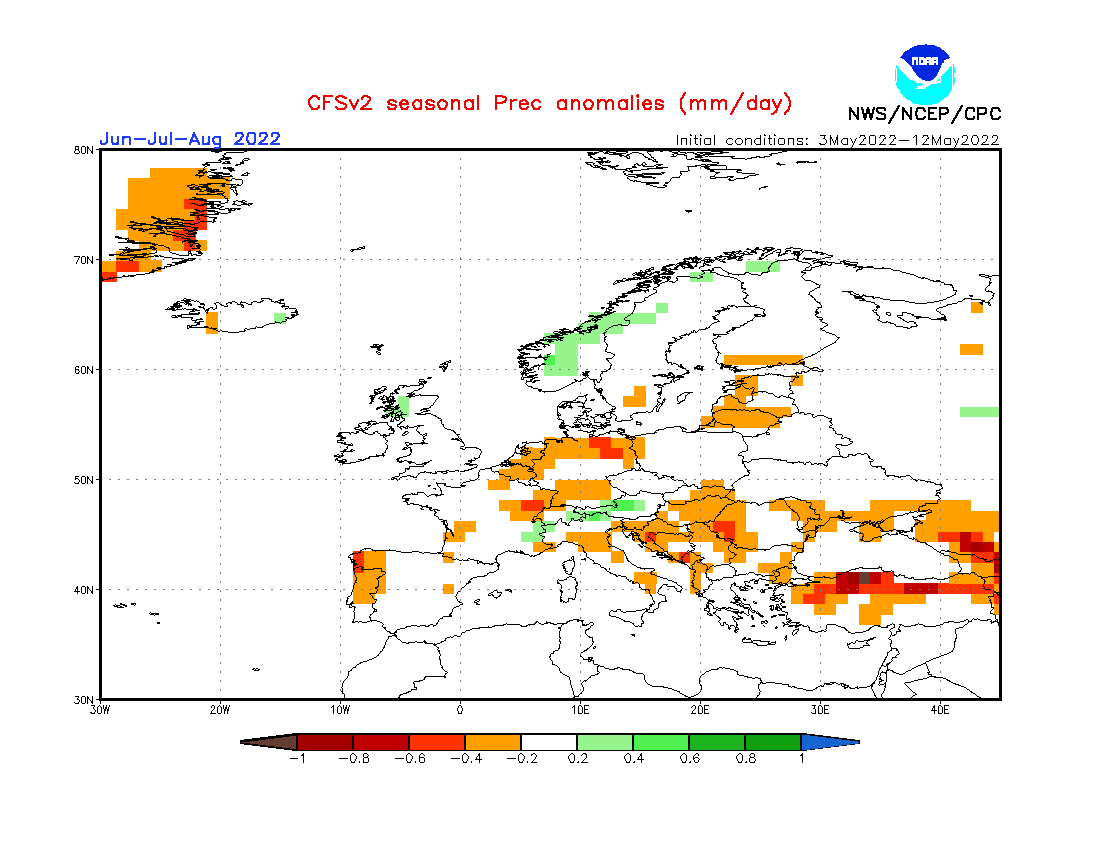
Over North America, the United States shows drier conditions over much of the central and northwestern United States. Especially the south-central states are forecast to be much drier than normal.
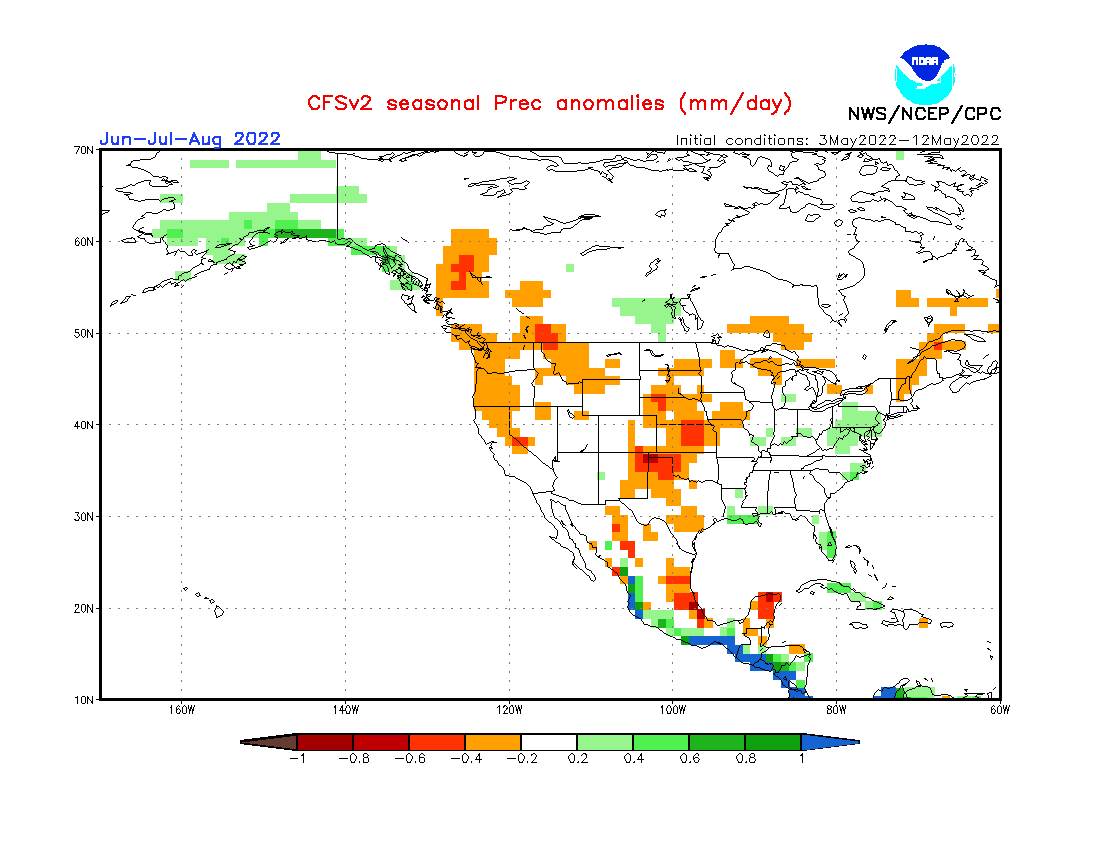
This is now a third model that is also forecasting a hotter and drier summer across the south-central United States. It gives high confidence for this scenario when different models come to a similar conclusion.
SUMMER 2022 WEATHER FORECAST – OVERVIEW
If reading image descriptions is confusing, we have put together a simple Summer forecast summary:
Europe is expected to have warmer/hotter than average summer over much of the continent, except for parts of northern and northwestern Europe.
There will still be cold fronts and severe weather events over central regions. The low-pressure area over northern Europe can send occasional cold fronts down from the north, increasing convective activity (storms).
Normal to wetter conditions are expected mostly over far northern Europe. The British Isles and Scandinavia could have a more unsettled Summer, as the jet stream positions just north of these regions, bringing along a higher chance for stormy weather.
North America’s summer forecast looks to be hot and dry. Most of the western and south-central United States is expected to have a hotter summer than normal. Above-average temperatures are also forecast for the northeastern United States and over central and eastern Canada.
Especially in the south-central United States, there is a high-confidence forecast for a drier summer. Along with hotter temperatures, this is a concern for continued drought conditions.
The Southern United States also has a warmer summer signal. But at the same time, the precipitation forecast shows normal to wetter conditions partially across the southwest, and over the eastern United States.
Overall, hot and dry summer is expected across the south-central United States in this updated outlook. Over the southwest and east, more storms are expected, as the forecast calls for higher temperatures and normal to above-normal precipitation.
Looking at the NOAA official Summer temperature outlook, most of the United States is warmer than hotter. The core warm anomalies are focused on the western half of the United States. Another warm zone is in the northeast, under the secondary high-pressure zone.

The official Summer precipitation forecast is quite similar to the model forecast and historical data. We have an equal-to-higher probability for more precipitation in the eastern United States and over parts of the southwest. But most of the northwestern and central United States is forecast to have a drier summer season.

The problem with precipitation in any La Nina season is typically the persistence of drought conditions in the southern and western United States. Below we have the latest drought analysis from NOAA, which shows the current drought conditions across the United States.
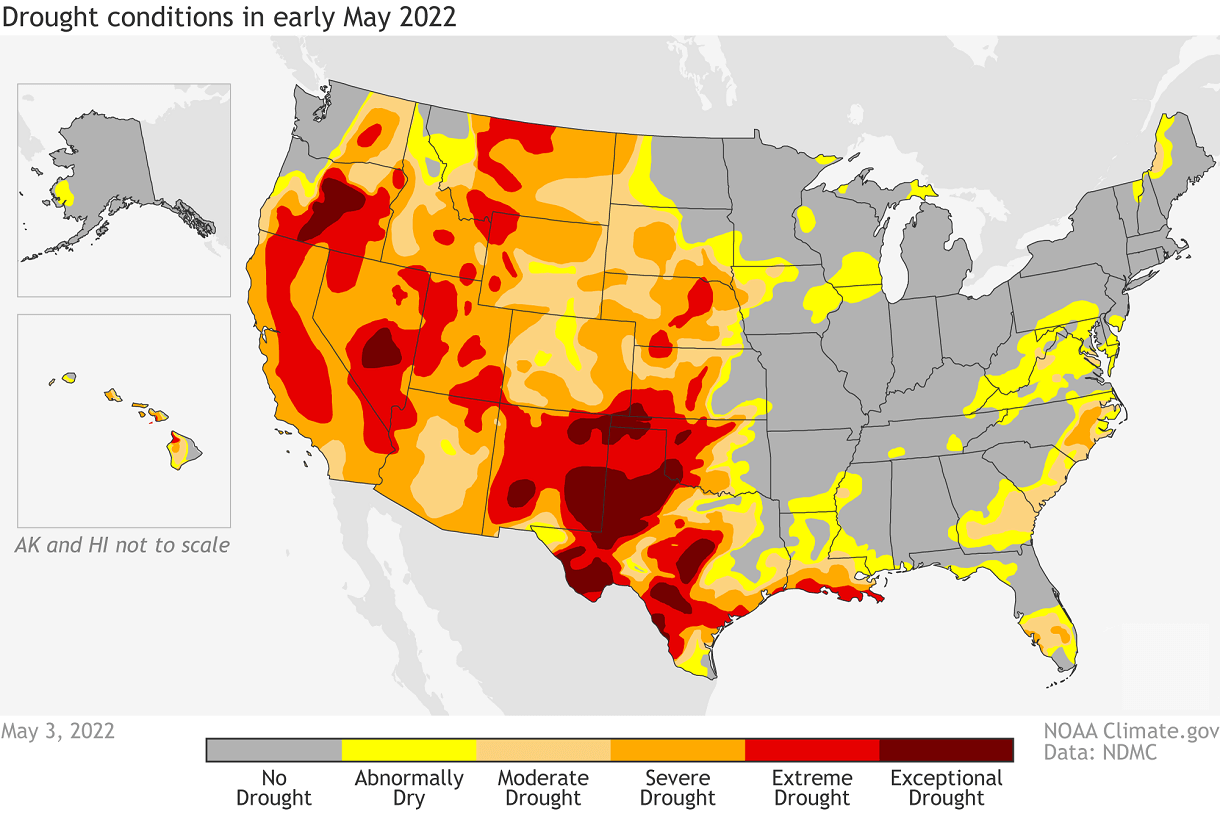
Most of the western half of the United States is under some level of drought conditions. The driest conditions prevail in the southern United States. A warmer and drier than normal summer, as currently forecast for the south-central and northwestern states, can sustain or worsen the drought conditions.
We will release regular updates as fresh forecasts and data are available. So make sure to bookmark our page. Also, if you have seen this article in the Google App (Discover) feed, click the like button (♥) there to see more of our forecasts and our latest articles on weather and nature in general.
SEE ALSO: